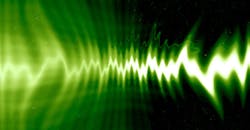Aiming for Repeatable THz S-Parameter Measurements
Wireless-communications applications are steadily moving higher in frequency, with fifth-generation (5G) wireless networks promising the regular use of millimeter-wave frequencies. For truly short-range communications links and other applications, such as medical diagnostics, signal frequencies in the terahertz (THz) range are not within reason, although such applications will require the support of commercial measurement solutions, such as vector network analyzers (VNAs) for S-parameter measurements.
The accuracy of such high-frequency measurements will depend on the quality of calibration standards and how calibrations are performed, since even improperly torqued waveguide flanges can result in measurement errors at those high frequencies. When VNAs are used with frequency extension modules to reach THz frequencies, any flexures in cables connecting a local-oscillator (LO) source to the frequency extension module can also destroy the repeatability of THz measurements.
Masahiro Horibe of the National Metrology Institute of Japan, National Institute of Advanced Industrial Science and Technology (Tsukuba, Japan) has seen the rising interest in higher-frequency signals, noting that by 2020, high-speed data transfers will be taking place at 340 GHz at the Tokyo Summer Olympic Games. He experimented with different waveguide flange interfaces, using precision claws with minimum tolerance to achieve rotational angular alignment necessary for minimal measurement errors at experimental frequencies as high as 1.1 THz. To explore the repeatability of different mounting arrangements, S11 measurements were made with 10 different connection and disconnection cycles, with magnitude and phase measurements made across a frequency range of 750 to 1050 GHz.
Horibe’s study investigated the effects of different waveguide flange designs on VNA measurement uncertainty at THz frequencies. The research revealed that IEC 60154-2 type-F waveguide flanges provide precise connection and good connection repeatability compared to other flange designs. Even such factors as the surface roughness of interconnections must be inspected and monitored to maintain good repeatability at VNA measurement frequencies as high as 1.1 THz.
Check out “Measurement Uncertainty in Terahertz VNAs,” IEEE Microwave Magazine, Vol. 19, No. 2, March/April 2018, p. 24.
About the Author
Jack Browne
Technical Contributor
Jack Browne, Technical Contributor, has worked in technical publishing for over 30 years. He managed the content and production of three technical journals while at the American Institute of Physics, including Medical Physics and the Journal of Vacuum Science & Technology. He has been a Publisher and Editor for Penton Media, started the firm’s Wireless Symposium & Exhibition trade show in 1993, and currently serves as Technical Contributor for that company's Microwaves & RF magazine. Browne, who holds a BS in Mathematics from City College of New York and BA degrees in English and Philosophy from Fordham University, is a member of the IEEE.

